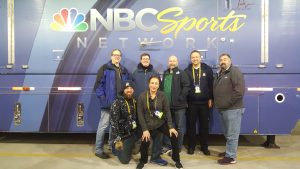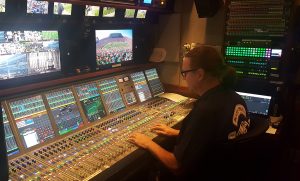NBC Sports Caps Second Year of Dolby Atmos for Notre Dame Football
New gear, enhanced techniques mark immersive evolution
Story Highlights
A second full season of Dolby Atmos audio applied to NBC Sports’ coverage of Notre Dame home-game football has wrapped, and the format is proving a winner for college football.
Atmos’s immersive audio is seen as the complement to 4K HDR broadcasts, which began in 2016 for the Notre Dame home games. NEP’s ND6 mobile production unit, which has been used for the past three seasons of the Notre Dame 4K HDR broadcasts, was outfitted with four overhead Genelec speakers to accommodate the 5.1+4 Atmos mix, along with a Dolby DP590 processor to emulate 5.1 and stereo downmixes. A key additional technology platform this season was the Linear Acoustic (Telos Alliance) UPMAX ISC Immersive Soundfield Controller. In addition, the broadcasts were available through Comcast’s 4K HDR set-top boxes this year, in addition to carriage by DirecTV, the sole distributor of the enhanced-audio broadcasts for the past two years.
“We made small refinements to the Atmos mixes week by week, but the overall goal was to re-create what you’d hear if you were in the stadium, including sounds from above,” explains Doug Deems, the freelance A1 who has been at the helm of the project’s mixes for two seasons.
One of the tweaks was splitting the two Audio-Technica BP4029 stereo short shotgun mics, which had been placed together on the roof on one side of the stadium last year: one on each side, a configuration Deems says further widened the overhead sound image and helped balance the PA system located at one end of the field. The use of stereo shotguns also helps maintain imaging as the audio undergoes surround and immersive processing.
Crowd sounds, which are critical elements in both surround and immersive audio channels for broadcast sports, are collected at three height levels for Atmos at Notre Dame Stadium: the traditional field level; at booth level, which is about halfway up the grandstands; and on the roof for the +4 channels. That configuration also helps keep the timing of the sound arrivals at those seats consistent with perspective for key sonic elements, such as the marching band, which was also miked more directly from four corner position around it.
“You’re hearing a bit of the band from the roof mics, which are about 200 ft. away, which duplicates the effect you’d get when you’re sitting in the stands,” Deems explains. “Also this year, we put the referee into the rears and left that mic open a crack all the time, so you can hear him whenever he speaks, but, when he’s on camera, I’ll open the mic up in front. It’s all about re-creating the actual space as you’d experience it if you were in the stadium. Atmos is great for that.”
The use of the Linear Acoustic ISC processor was more important this season, he adds. It was placed across the 5.1-output EVS tape bus of the console so that all stereo, 3.0, and 5.1 playback was upmixed to 5.1+4 in the truck. The discrete–10-channel immersive mix was set from the truck to NBC Sports’ main control facility in Englewood Cliffs, NJ, where encoding to Atmos takes place prior to transmission. A second ISC processor was added this year, applied to stereo music tracks and other audio elements that came in diverse channel formats, from stereo to 3.0 to surround.

NBC Sports audio team for Notre Dame football: (back row, from left) Doug Deems (A1), Grant Greene (RF), Ben Banik (field/parab), Jeff Bullard (set), and Chris Ross (compound); (front row, from left) Chris Tetzlaff (field/parab) and Sarali Anastasion (booth)
“We use a lot of commercial music tracks for the Notre Dame games, and I started using the second ISC around weeks four and five, to spread the music tracks out more evenly naturally, rather than just spreading stereo tracks 60/40 front to rear and then duplicating that in the overheads,” he says. “Stereo-music compatibility tends to suffer when you run it with an immersive mix, so, to avoid that, I’m upmixing it to 5.1 and then running it through the ISC, which makes it sound more natural in a three-dimensional space and better preserves the stereo mix. The cymbals, for instance, tend to move up in the mix and sparkle. Prince’s tracks sound especially good in immersive.”
Deems has added one other device to this season’s audio arsenal. He’s using a JoeCo BBR multitrack system to record the games’ immersive tracks and other stems, then listen back and experimentally tweak the mixes further during setup and other downtimes between broadcasts. It’s a take on the use of a similar technique, known as a virtual sound check used by live sound mixers — a role Deems played more than two decades ago as a tour-sound monitor mixer for Kid Rock, David Sanborn, Pink, and Backstreet Boys, among others — to fine-tune a mix using a show’s actual elements.
“The thing I think we take away from the Notre Dame games is how young immersive audio really is,” he says. “I’ve done 14 games in two seasons; that’s less than the number of games in a single NFL season. There’s still a lot to learn, but I think Karl [Malone, director, sound design, NBC Sports and NBC Olympics] and Jim Starzynski [director and principal audio engineer, NBCUniversal Advanced Engineering], and I, as well as everyone else involved, from the Dolby guys to people listening at master [control] and giving notes, have made excellent progress towards defining how to use this new vocabulary to better bring the fan at home right into the stadium.”

